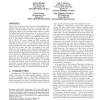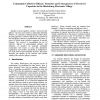241 search results - page 18 / 49 » Understanding Social Networks Using Formal Concept Analysis |
RE
2006
Springer
13 years 7 months ago
2006
Springer
Aspect-oriented concepts are currently introduced in all phases of the software development life cycle. However, the complexity of interactions among different aspects and between...
WH
2010
13 years 2 months ago
2010
What is the role of face-to-face interactions in the diffusion of health-related behaviors- diet choices, exercise habits, and long-term weight changes? We use co-location and com...
SUTC
2008
IEEE
14 years 1 months ago
2008
IEEE
Semantic understanding of multimedia content has become a very popular research topic in recent years. Semantic concept detection algorithms face many challenges such as the seman...
WWW
2009
ACM
14 years 8 months ago
2009
ACM
We analyze knowledge production in Computer Science by means of coauthorship networks. For this, we consider 30 graduate programs of different regions of the world, being 8 progra...
HICSS
2003
IEEE
14 years 25 days ago
2003
IEEE
Bandura’s social cognitive construct “perceived selfefficacy” has been used widely to understand individual behavior as a function of domain-specific beliefs about personal ...



